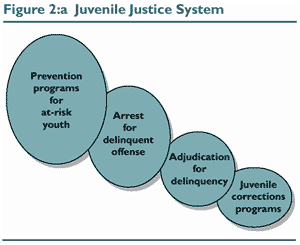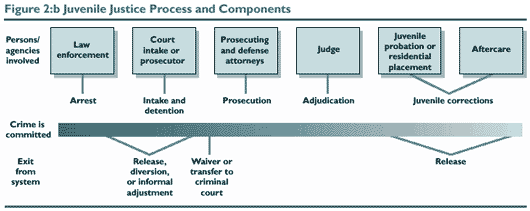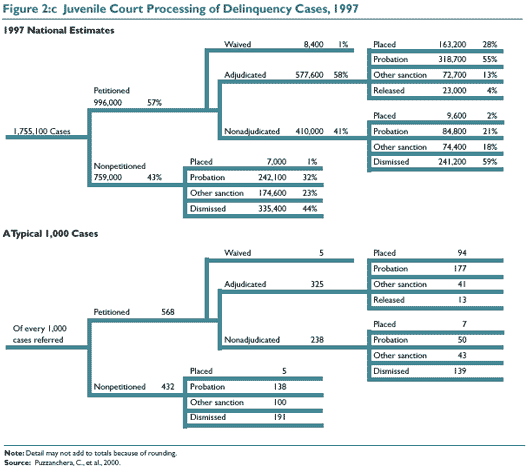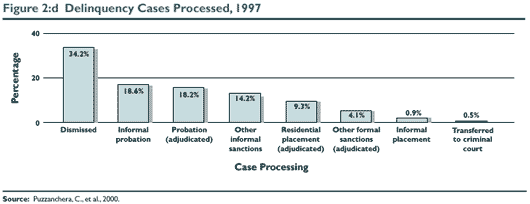Chapter 2: Jurisdictional and Program Self-Assessment
The Components and Processes of the Juvenile Justice System
 The juvenile justice system is large and complex, and its processes and components vary greatly from State to State. Figure 2:a depicts a simplified illustration of the relationship of juvenile corrections to the rest of the juvenile justice system. At the entry point, services and programs need to be very broad and serve the largest group of young people, with prevention programs for at-risk youth. With effective prevention programs that include family-strengthening strategies and support of community institutions, progression of many youth further into the juvenile justice system can be averted.
The juvenile justice system is large and complex, and its processes and components vary greatly from State to State. Figure 2:a depicts a simplified illustration of the relationship of juvenile corrections to the rest of the juvenile justice system. At the entry point, services and programs need to be very broad and serve the largest group of young people, with prevention programs for at-risk youth. With effective prevention programs that include family-strengthening strategies and support of community institutions, progression of many youth further into the juvenile justice system can be averted.
At the next juncture of the system after prevention programming, youth who commit delinquent offenses are arrested. At this point, some youth will be released or diverted. If the crime is not a serious one and law enforcement officers believe a youth will not be a risk to himself or herself or to the public, a youngster may be released without further involvement in the juvenile justice system. Other youth will proceed further in the system and be scheduled for formal processing in juvenile or family court, and they may or may not be held in detention. A few who have committed the most serious offenses may be waived to (adult) criminal court. Youth who are formally processed in the juvenile justice system will be adjudicated. Some of these cases will be dismissed, and the youth involved will be released from further involvement with the court. Others will be adjudicated as delinquent and will proceed to juvenile corrections programs or other dispositions. The system narrows the number of youth at every successive point, resulting in fewer youth reaching the most restrictive corrections programs at the end of the system.
Juvenile corrections programs work with the smallest number of youth, but they usually have the most intensive involvement with them. Corrections programs include community supervision (probation), nonresidential programs and services, and residential programs such as group homes, ranches or camps, and institutions. Boot camps and day treatment programs recently have been developed, contributing to the full spectrum of juvenile corrections programs. In addition, aftercare programs or parole may be used to supervise and assist youth with reintegration into the community following a residential placement. There are many subcomponents of each type of corrections programming, such as intensive supervision and electronic monitoring within community corrections. Residential programs may serve general populations with standard services or special groups of youth with services that are specific to their problems, such as substance-abuse or sex-offender treatment.
A more common view of the juvenile justice system is a linear one that depicts the progress of youth through the system. Figure 2:b shows this process and the elements of the system involved. Although juvenile justice systems and processes vary somewhat in activities and labels from State to State, their general operation is fairly consistent with that in Figure 2:b. The thick horizontal line represents a youth's path through the system and possible points for exiting it. The top row shows the various entities responsible for each of the functions shown across the top of the line.

When a crime is witnessed or reported, law enforcement personnel investigate, apprehend, and may arrest the youthful offender. Depending on the crime, community resources, and community values and norms, some youth may exit the juvenile justice system after apprehension and/or arrest. Programs, such as educational and recreational programs, drug prevention or treatment, and counseling services, to which law enforcement personnel can refer youth whose delinquent behavior is not serious are in place in some communities. Youth referred to these programs may have no further involvement with the juvenile justice system (Bureau of Justice Statistics, 1997).
Generally, however, youth who are arrested will go through an intake process. They may be held in detention prior to their initial hearings or released to their parents or guardians. An intake process begins within a short time after arrest so that the court can determine whether formal proceedings will occur. Some youth remain in detention until their cases are prosecuted and adjudicated, whereas others are released until they return to court. Some youth may exit the system after the intake hearing, through either a total release or referral to a diversion program. For youth who have committed very serious crimes, are nearing legal adulthood, and/or are chronic offenders, a waiver or transfer process may result in the (adult) criminal court taking jurisdiction over the case (Bureau of Justice Statistics, 1997).
A case that proceeds for formal processing by the juvenile court usually involves a prosecuting attorney and juvenile court judge. A defense attorney is also available to the youth. In some States, juries may be used in juvenile cases. After the adjudication hearing, the youth either is determined to be a delinquent or is released. If the court finds the youth delinquent, it makes a disposition. Usually, this involves placing the youth on informal supervision or formal community supervision or in a residential facility. Informal supervision may place some requirements or restrictions on the youth for which they are responsible to the court. For example, a youth may have to pay restitution or perform community service. When that obligation is completed, the youth is released. If the youth does not abide by the agreement, he or she may be returned to court for a more formal disposition. Juveniles under formal community supervision are placed on probation and supervised by a probation officer. Usually, the judge imposes conditions on the youth while the youth is on probation (e.g., obeying all laws, participating in treatment, performing community service). The probation officer is responsible for making assessments, case plans, and referrals; supervising the youth's progress; enforcing the court's conditions; and returning the youth to court, if necessary. After completing probation, the youth may be released (Bureau of Justice Statistics, 1997).
Some youth, particularly those who are serious, violent, or chronic offenders, are placed in residential facilities. This confinement may be considered necessary for public safety or for the treatment of youth. Residential programs are responsible for the youth's total care, treatment, and well-being. Following a residential placement, youth usually receive aftercare services through which professionals supervise, monitor, and assist them with reintegration into their families and the community (Bureau of Justice Statistics, 1997).
Figure 2:c provides another view of the processing of delinquency cases through juvenile courts. As youth proceed through the system, fewer and fewer cases remain in the system. In 1997, the year on which the data in Figure 2:c are based, less than half (43 percent) of the cases that entered the system led to probation or placement in a residential facility. Although there may be some variation among formally adjudicated, nonadjudicated, and nonpetitioned cases, these represent the cases usually referred to juvenile corrections programs.

Figure 2:d shows the extent to which case numbers decrease as youth progress through the juvenile justice system. Of all cases processed by juvenile courts in 1997, about one third (34.2 percent) were eventually dismissed. That year, 18.2 percent of juvenile court cases were adjudicated and placed on probation, while 18.6 percent were not adjudicated but received some type of probation supervision (informal probation). Overall in 1997, only 9.3 percent of cases were eventually adjudicated and placed in residential programs, while just under 1 percent were nonadjudicated but resulted in voluntary placement in residential programs (informal placement).

It is the relatively small group of youth who enter juvenile corrections programs and the juvenile corrections programs that serve them that are the focus of this manual. Juvenile corrections programs work with youth for longer periods and more comprehensively than other parts of the system. Because of this, they also require a disproportionate amount of resources, especially residential corrections. It is estimated that the cost of incarcerating one juvenile for 1 year averages approximately $36,500 (Corrections Yearbook, 1995).
| Jurisdictional Technical Assistance Package for Juvenile Corrections | Report - December 2000 |